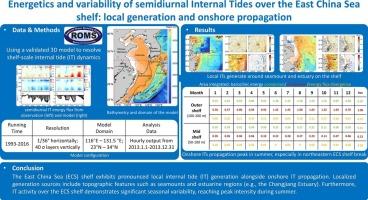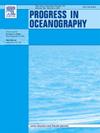东海陆架半日内潮的能量学和变率:局地成因与远地强迫
IF 3.6
3区 地球科学
Q1 OCEANOGRAPHY
引用次数: 0
摘要
内潮(ITs)是驱动分层海洋湍流混合的重要能量来源。东中国海(ECS)大陆边缘是主要的信息技术生成热点,但其广阔大陆架上的信息技术可变性仍然缺乏约束。利用具有真实强迫的高分辨率模型,我们研究了ECS的半日IT能量学和变异性。结果显示强烈的季节性,IT活动高峰在夏季,主要是由分层变化驱动的。两种不同的机制有助于陆架上ITs的形成:(1)孤立地形特征的局部产生和(2)大陆架断裂的陆上传播。分析表明,局地发电在整个大陆架的IT能源预算中占主导地位(在浅于200米的深度上总计1.32 GW),特别是在包括长江口地区和中大陆架海山在内的突出地形隆起处。尽管来自该区域的岸上传播IT能量通量对大陆架总能量收支的贡献相对较小,但岸上IT传播严重调节了局部IT动态,特别是在大陆架外区域(100 - 200 m深度范围)。它在It能量传输中产生了明显的跨等深线不对称,在200米等深线处,陆上通量超过海上通量2.3倍(0.25吉瓦对0.11吉瓦),在100米等深线处,陆上通量超过海上通量1.9倍(19.22兆瓦对10.04兆瓦)。这些陆上能量通量受陆架断裂产生强度和地形临界性的调节,在台湾岛东北部和沿ECS陆架断裂北部达到峰值。这些通量在调节相邻区域的现货信息技术变异性方面发挥了重要作用。本文章由计算机程序翻译,如有差异,请以英文原文为准。

Energetics and variability of semidiurnal internal tides across the East China Sea shelf: Local generation versus remote forcing
Internal tides (ITs) represent a crucial energy source driving turbulent mixing in stratified oceans. The East China Sea (ECS) continental margin is a major IT generation hotspot, yet IT variability across its broad shelf remains poorly constrained. Using high-resolution modeling with realistic forcing, we investigate semidiurnal IT energetics and variability in the ECS. Results show strong seasonality with peak IT activity in summer, primarily driven by stratification changes. Two distinct mechanisms contribute to the on-shelf ITs: (1) local generation at isolated topographic features and (2) onshore propagation from the ECS shelf break. Analysis demonstrates that local generation dominates the IT energy budget across the ECS shelf (1.32 GW integrated over depths shallower than 200 m), particularly at the prominent topographic rises including the Changjiang Estuary area and middle-shelf seamounts. Although the onshore-propagating IT energy fluxes from this region contribute relatively little to the total shelf energy budget, the shoreward IT propagation seriously regulate the local IT dynamics, especially in the outer shelf regions (100 – 200 m depth range). It has generated a pronounced cross-isobath asymmetry in IT energy transport, with onshore fluxes surpassing offshore fluxes by a factor of 2.3 at the 200-m isobath (0.25 GW vs. 0.11 GW) and 1.9 at the 100-m isobath (19.22 MW vs. 10.04 MW). These onshore energy fluxes, regulated by both shelf-break generation intensity and topographic criticality, peak northeast of Taiwan Island and along the northern ECS shelf break. These fluxes play a substantial role in modulating on-shelf IT variability in adjacent areas.
求助全文
通过发布文献求助,成功后即可免费获取论文全文。
去求助
来源期刊

Progress in Oceanography
地学-海洋学
CiteScore
7.20
自引率
4.90%
发文量
138
审稿时长
3 months
期刊介绍:
Progress in Oceanography publishes the longer, more comprehensive papers that most oceanographers feel are necessary, on occasion, to do justice to their work. Contributions are generally either a review of an aspect of oceanography or a treatise on an expanding oceanographic subject. The articles cover the entire spectrum of disciplines within the science of oceanography. Occasionally volumes are devoted to collections of papers and conference proceedings of exceptional interest. Essential reading for all oceanographers.
 求助内容:
求助内容: 应助结果提醒方式:
应助结果提醒方式:


